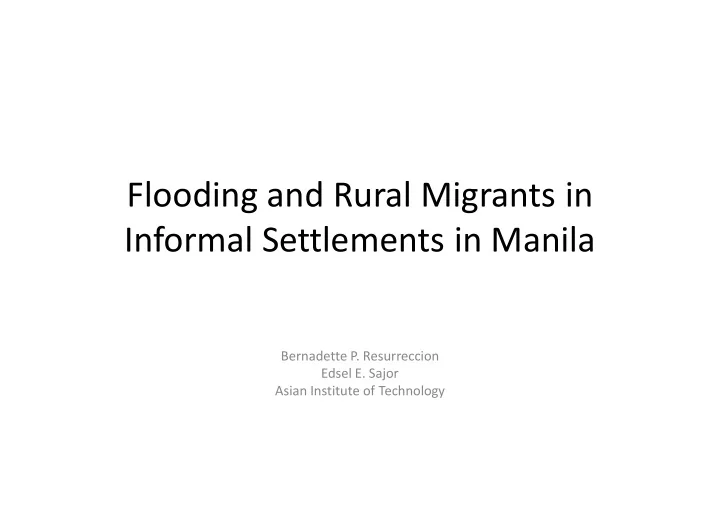

Flooding and Rural Migrants in Informal Settlements in Manila Bernadette P. Resurreccion Edsel E. Sajor Asian Institute of Technology
Study site: Malabon City, Metro Manila Our preliminary scoping exercise reveals the following: – Presence of small industrial estates – Coastal, low-lying towns in the city – Proliferated by informal settlements – There are 14 open waterways and 5 rivers, 3 of which are linked to Manila Bay – Perennial flooding – Flat topography • Urban sites are ecologically fragile lands: e.g., flood-prone areas along river banks, polluted brown fields near polluting industries, settlements by the railroad • Settlements are usually informal and housing rent rates are lowest • Rural migrants densify and occupy these urban sites as these are accessible to workplaces and are affordable shelters
Typhoon Ketsana • September 2009 • Highest precipitation recorded: 454.9 mm • Estimated cost of damages is PhP10.45 billion broken down into : – Infrastructure - PhP 3.684 Billion (85.68M USD) – Agriculture PhP 6.766 Billion (157.35M USD) • Casualties in Metro Manila: 173 dead • Damaged Houses: 101,278 (25,259 totally and 76,019 partially) • Shelter is severely affected and damaged • Food supply was disrupted
Vulnerability of migrants • They live with physical risks but simultaneously are able to engage in livelihoods since shelter is affordable vis-à-vis their low wages • Their low economic status constrain their ability to recover fully from the dislocations caused by floods • Support for them after floods is only accessible to them through their highly insecure employment and informal networks within and beyond Malabon city • Access to good drainage systems, flood-control infrastructure, and pertinent basic services may be socially uneven and possibly very weak within their informal settlements
Migration and migrant status mediate migrants’ vulnerabilities • Support mechanisms through networks may be patchy and uneven • They return to these settlements and rebuild, creating a cycle of vulnerability • In addition, networks of kinship and town mates are present and support migrant survival strategies in these urban areas in possibly socially-uneven ways according to age, gender, ethnicity and religion
Policy environment • Due to the informality or illegal status of many of their settlements they are neglected by governments on such basic services provisioning and infrastructures as drainage systems, flood- control infrastructure, and reliable water and sanitation facility. • Migrant communities are usually harnessed into a mechanism of patron-client dependency in urban electoral politics, enjoying fleeting and opportunistic support from local politicians vying for their votes during election. But such support is not formally institutionalized in the local government functioning. • In situ rehabilitation and consequent flood protection are often a non-priority by the local government due to their informal settlement status. This negatively affect the resilience of these communities in future flooding events. • Migrants are a non-priority to local government’s social housing program for low-income and the poor and therefore alternative housing to safer places in the same municipality is extremely difficult. The confluence of demographic densification, government neglect, and socio-economic attributes and relations of poor migrants in informal settlements may build chain of vulnerabilities over time and seriously limit resilience building.
Problem Statement The study aims to characterize the cycle of production and reproduction of vulnerability and adaptation of poor migrants and their communities in cities: – First order: build-up of sensitivity to flood stress by individual migrants and communities’ patterns of behavior and development (historical) – Second order: immediate impacts of disaster and comparative disadvantage (event analysis) – Third order: post-disaster rehabilitation and further reproduction of sensitivity through migrants’ adaptive response and government action in the medium term (diachronic) Thus, the need for a three clustered analysis of processes involved in flood adaptation by migrants, their communities, and government response.
Thank you. Dr. Edsel E. Sajor Dr Bernadette P. Resurreccion Asian Institute of Technology
Recommend
More recommend